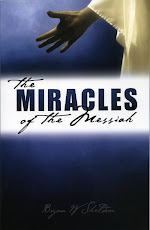The
Significance of the Signs in John’s Gospel
The signs for the nation before His
rejection included turning the water into wine, healing the ruler’s son who was
at the point of death, the impotent man at the pool of Bethesda, and feeding a multitude of
people. These indicate that when Messiah
came to them, the nation was a nation in captivity, without freedom and under a
hard rule, not only that of Rome,
but also that of the Sanhedrin.
(i)
They were without blessing and without joy, as in the
first sign, they had no wine.
(ii)
Nationally, they were on the point of death, as in the
second sign.
(iii)
The third sign reflects their impotence as a nation, an
impotence that was the result of sin, especially that of their leaders.
(iv)
In consequence, the people were like sheep without a
shepherd, which is the context of the fourth sign.
If they had trusted their Messiah,
(i)
they would have had joy “up to the brim”, as at the
wedding in Cana (John’s first sign).
(ii)
they would have been restored from the point of death
as with the nobleman’s son (John’s second sign)
(iii)
given a new start with a new purpose, as with the
paralytic at the pool of Siloam (John’s third sign), and
(iv)
would have been fed (physically, intellectually and
spiritually) by Jesus the Good Shepherd, as was the great crowd (John’s fourth
sign).
However, the majority of the nation were categorised as “wicked”,
“evil” and “adulterous”. They believed
neither the Scriptures nor their Messiah.
They followed the lead of the Sanhedrin and rejected the Messianic
claims of Jesus. Jesus would give them one
last national sign, the sign of the prophet Jonah. The first element of sign of
the prophet Jonah was the raising of Lazarus (the seventh significant miracle
in John). This Messianic attesting miracle
was not a call to the nation to change their attitude to Him, but a practical
exercise to demonstrate that nothing can melt the hard hearts of those who do
not believe the Scriptures, not even someone rising from Hades. The obdurate
unbelief of the Jews of Jerusalem, and the Sanhedrin in particular, was
stripped bare for all to recognise.
The disciples, on
the other hand, were a believing remnant, and saw His glory:
(i)
At a wedding,
in a context of love, when He brought joy by providing wine for the blessing of
bride, groom and guests. (sign 1)
a.
It would be a joy,
that for the disciples, would be complete and enduring: “These things I have
spoken to you so that My joy may be in you, and that your joy may be made full”;[1]
b.
It would be a joy
in a context of love: “Just as
the Father has loved Me, I have also loved you; abide in My love”.[2].
(ii)
On the sea,
when He walked on water and calmed the storm, signifying there was no tempest
that would be able to engulf them (sign 5)
a.
His peace is
effective in all situations; “Peace I leave with you; My peace I give to you;
not as the world gives do I give to you. Do not let your heart be troubled, nor
let it be fearful.”[3]
(iii)
At the pool of
Siloam, where He opened the eyes of a man born blind (sign 6) demonstrating
that He is the Light of the world
a.
While they followed Him they would always walk in His light: “I have come as Light
into the world, so that everyone who believes in Me will not remain in
darkness.”[4]
(iv)
At a graveside,
where He raised the dead (sign 7)
a.
He provides resurrection life: “For as in Adam all die, so also in Christ all will be made
alive. But each in his own order: Christ the first fruits, after that those who
are Christ’s at His coming”[5]
(v)
At the lakeside,
where they dined on bread and fish (sign 8),
a.
In the context of the resurrection, they enjoyed fellowship: “What we have seen and
heard we proclaim to you also, so that you too may have fellowship with us; and
indeed our fellowship is with the Father, and with His Son Jesus Christ.”[6]
For those
who received Him as Messiah, He promised eternal joy, love, peace, light, life
and fellowship.




